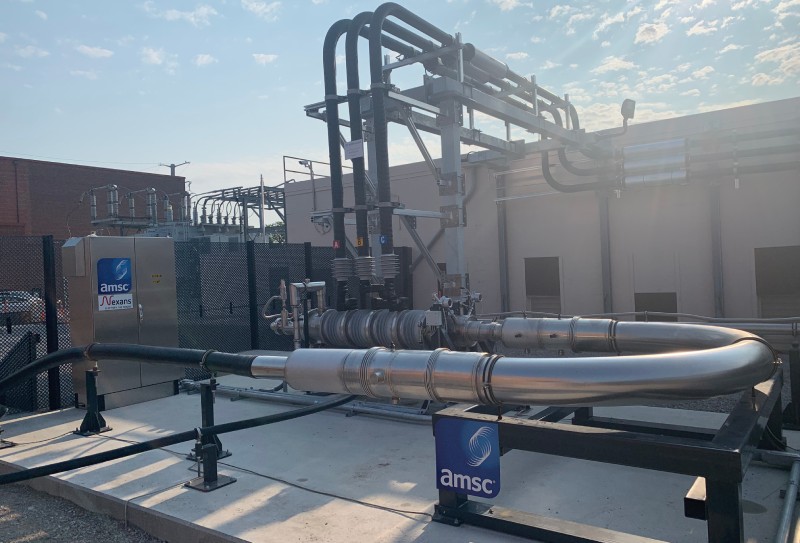Superconductivity

Maximum transmission capacity with no losses
We are world leaders in the design and manufacture of superconducting cable systems and superconducting fault current limiters (SFCLs).
Superconductivity is the loss of electrical resistance that takes place in some materials when they are cooled to extremely low temperatures. First discovered in 1911, it is a phenomenon with major implications for the way electricity is transmitted and distributed.
Cables incorporating superconducting wires or tapes are near-perfect electrical conductors in a highly compact form. Superconducting cables for electricity transmission are manufactured using materials known as High Temperature Superconductors (HTS).
The word “high” in this context is relative. Before the discovery of HTS in the late 1980s, superconducting involved cooling to extremely low temperatures, typically to -269°C with liquid helium. For high-temperature superconductors, cooling to -200°C is sufficient, and this temperature is easily accessible with liquid nitrogen. Liquid nitrogen is inexpensive, abundant and harmless to the environment. The superconducting conductor of a cable is immersed in a continuous flow of liquid nitrogen and placed in a cryogenic envelope guaranteeing excellent thermal insulation.
With more than 20 years of experience, we are the leading innovators in superconducting systems. Our proven track record attests to our advanced engineering expertise and capabilities in HTS cables and fault current limiters. We’re not just shaping the future; we’re helping to power up the electrical grid, revolutionize energy transmission reliability, elevate energy network resilience, and minimize infrastructure as well as environmental impacts.

Challenges associated with superconducting cable systems
Transport, heating and industry will all need to be electrified in the coming years to meet net zero goals. The biggest increase in electricity demand will be in cities. For this reason, consolidating urban distribution networks is a priority.
Our market-proven superconducting cables are transforming urban power networks. Grid operators are able to transmit more power while reducing both land take and investment, and eliminating stray heat and electromagnetic field emissions (EMF).
10%
the power loss of conventional long-distance transmission systems using aluminum and copper conductors
-200°C
cooling required for high-temperature superconductors, accessible with liquid nitrogen
Nexans solutions
Deliver end-to-end superconducting solutions, from initial concept to deployment and commissioning, backed up by expert services and support.
Protect grid assets with our superconducting fault current limiters (SFCLs), providing fast protection from fault currents. Superconducting fault current limiters can be used with any type of distribution network and any type of cabling, particularly conventional copper and aluminum cables. They make it possible to expand existing networks and connect distributed renewable energy sources without upgrading existing structures.
Transform urban energy with high-temperature superconducting (HTS) cables of exceptional characteristics:
- Minimal footprint: HTS cables require up to ten times less space than conventional cables. Fewer cables are needed and phases spacing is not required. This scales down right-of-way requirements, minimizes disruption for local residents, accelerates deployment and keeps costs down.
- Energy efficiency: superconducting cables are ultra-efficient conductors with zero or near-zero resistance. The energy savings achieved are greater than the energy required to maintain the conductors at a low temperature.
- Zero heat impact: superconducting cables emit no heat, regardless of the power transmitted. They can be buried directly underground or laid at greater depths, cutting project delivery times and reducing costs by avoiding structural engineering work on existing installations. Transmission capacity is not affected when other cables are routed nearby. Last, they do not dry out the soil, a phenomenon that may lead to the emission of heat by conventional cables.
- No need for new tunnels: where tunnels or pipes already exist, retrofitting HTS cables to complement or replace conventional cables considerably increases transmission capacity.
- Smaller electromagnetic fields (EMF): the electromagnetic field generated by HTS cables per building is negligible, minimizing impact on surrounding infrastructures and alleviating public concerns about EMF.
Help our customers take advantage of the opportunities offered by superconducting systems, using our unique capabilities in R&D, innovation, testing, manufacturing and deployment.
Maintain our position as world leaders in flexible cryogenic envelope technology, a key asset for superconducting cable systems.
Continue to play a key role in developing new standards as a member and Chair of TC 90, the dedicated committee set up by the International Electrotechnical Commission (IEC) to prepare international standards for superconducting materials and devices.
The industrialization of superconductivity is revolutionizing the path toward a more efficient and modern energy grid. With its advancing technology readiness and ongoing breakthroughs, superconductivity serves as a powerful catalyst for accelerating the energy transition and achieving Net-Zero targets.

Acceleration Units Director, Nexans

Superconductivity: Powering a new era of energy infrastructure




Frequently asked questions about superconducting cables

Find out more about superconducting cables
Dive into the fascinating world of superconductivity and explore how it revolutionizes our way of generating, transmitting, and distributing electricity. This white paper takes you to the heart of innovations that will shape our energy future.
Download the white paper now and immerse yourself in the energy of the future!
Download the report (PDF – 3MO)








